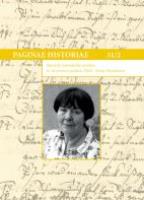Marie Maxmiliána ze Šternberka, roz. z Hohenzollernu - exemplum ctnosti a podporovatelka jezuitů v Čechách
Marie Maximiliane von Sternberg, née von Hohenzollern – Exemplum of Virtuousness and Supporter of the Jesuits in Bohemia
Author(s): Petra OulíkováSubject(s): History, History of Church(es), 16th Century, 17th Century
Published by: Národní archiv
Keywords: noblewomen; order, Jesuits; donors; Jesuit colleges
Summary/Abstract: Marie Maximiliane von Sternberg (1583–1646) descended from the noble family of the Hohenzollern-Sigmaringen counts of Swabia but she spent most of her life in Bohemia. She first married Jáchym Oldřich of Hradec (Joachim Ulrich von Neuhaus, 1579–1604) in 1598 who died six years later. She remarried in 1605, this time to Adam II von Sternberg (1554–1623). They both hailed from significant Bohemian aristocratic families. After Adam’s death in 1623, the countess did not marry again and led an exemplary widow’s life for twenty-five long years.Marie Maximiliane von Sternberg paid special attention to the upbringing and education of young people. Perhaps it is the reason why she primarily supported the Society of Jesus. While living in Jindřichův Hradec, the residential town of her first husband, she dedicated a large amount of money to the Jesuit seminary. The countess further continued to support the Jesuits after her move to Prague. A great financial gift enabled her to found the Jesuit College in the New Town of Prague. In addition, Marie Maximiliane von Sternberg established a local gymnasium and earmarked a sum of money to found Saint Francis Xavier Seminary. She was instrumental in building the chapel of the dead (capella defunctorum) at the Jesuit church of Saint Nicholas in the Lesser Town of Prague where the members of the fraternity of the Loyal Dead assembled. After the premature death of her son Adalbert Ignatius Eusebius von Sternberg in 1633, she commissioned a tomb for him and herself in the Jesuit church of Saint Salvator in the Old Town of Prague. Since the countess lived up to the expectations of a widow’s virtuous life, the Jesuit historian Bohuslav Balbín mentioned her in his book Bohemia sancta as an archetype of a person with a spotless reputation.
Journal: Paginae Historiae
- Issue Year: 31/2023
- Issue No: 2
- Page Range: 92-104
- Page Count: 13
- Language: Czech

